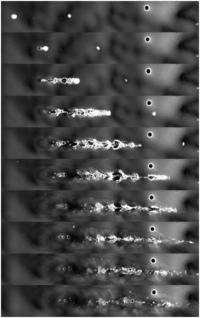FLuTE warmly invites you to attend their seminar on the 09 October at 16:00.
Refreshments will be provided upon arrival.
Experimental study of air entrapment at oblique impact of a body at a free surface
Guest speaker:
Andrey V. Cherdantsev
Senior Researcher in Kutateladze Institute of Thermophysics, Novosibirsk, Russia
Abstract:
In annular gas-liquid flow, droplets are torn from liquid film surface and entrained by turbulent gas stream. Impacts of the entrained droplets back onto the film occur at shallow angles and high impact velocities. In such a case, a droplet creates a long and narrow "furrow" on liquid surface, which is accompanied by massive entrapment of gas bubbles into the liquid film (see Fig. 1). This phenomenon is different from the known mechanisms of air entrapment such as air cushioning; its nature is not entirely clear and deserves intensive experimental and theoretical investigation.
First part of the presentation reports on experimental study of oblique high-speed droplet impact in "natural" conditions of annular two-phase flow in a horizontal rectangular duct using three-dimensional and stereoscopic Laser-Induced Fluorescence approaches. The results are focused on the effect of parameters of an individual droplet on the type and shape of liquid surface perturbation and intensity of bubbles entrapment. The contribution of this phenomenon into total amount of bubbles inside the liquid film and its role in evolution of the whole ensemble of bubbles are analysed.

The second part presents the results of model experiments on impact of a large (21.3 cm) solid sphere onto a stagnant layer of liquid. This study is focused on air-cushioning mechanism of entrapment and elucidates the very initial stage of impact, prior to the contact between the solid body and the liquid. Despite that the sphere may embed into liquid by 5-6 mm, it is still separated from the liquid by a thin continuous air layer. Synthetic Schlieren technique is employed for spatiotemporal measurements of the shape of the liquid surface and the air layer, including the dynamics of the crater and different kinds of waves produced by the impact.
Figure 1. Quantitative LIF visualisation of an oblique (~5º) impact of a fast (20 m/s) droplet onto thin (~0.3 mm) base film in annular-dispersed flow (superficial gas velocity 25 m/s, liquid film Reynolds number 220). Local brightness of the image is directly proportional to local film thickness; white corresponds to thickness of 1 mm. Size of the area is 28 * 4 mm2, time step is 0.2 ms. Droplet diameter is 0.71 mm.
Further experimental and theoretical studies will be aimed at clarification of the physical mechanism of air entrapment for oblique high-speed impact and at the influence of the impact angle on air-cushioning entrapment.
The work is supported by Russian Science Foundation (project 19-19-00287).
Bio:
Andrey Cherdantsev is Dr. Sc. who works as Senior Researcher in Kutateladze Institute of Thermophysics, Novosibirsk, Russia. In 2013-14 he stayed at the University of Nottingham as a visiting academic. His scientific interest is in multiphase flow area, being focussed on dynamics of waves, droplets and bubbles in annular gas-liquid flow and interaction between them. He develops Laser-Induced Fluorescence technique to study these transient processes. Author of over 20 journal papers.